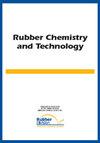senmanat拉伸流变仪的替代使用,以研究工业橡胶在非常大的变形下的流变行为
IF 1.5
4区 工程技术
Q4 POLYMER SCIENCE
引用次数: 1
摘要
拉伸变形是探索支化聚合物和弹性体丰富流变响应的有效刺激,使设计具有特定分子结构的聚合物成为可能。然而,探测聚合物在大变形下的行为通常受到实验装置的限制。我们在这里介绍了Sentmanat拉伸流变仪(SER)的另一种使用方法,该方法允许Hencky应变单位远大于可实现的最大值~3.6。所提出的程序包括在测量区域内对样品进行倾斜定位。如果使用小倾角的样品,在Hencky应变<1时,与理想单轴流的偏离可以忽略不计,而在较大的值时,偏离几乎为零。将线性粘弹性区域的实验结果与双报告模型进行比较,以识别多分散性和支化效应,而将拉伸流变学数据与分子应力函数理论(MSF)进行对比,揭示了聚合物结构的重要信息,特别是长链支化(LCB)的重要信息。最后,对样品拉伸失效的分析使我们能够将聚合物结构与混合过程中的流变行为联系起来。本文章由计算机程序翻译,如有差异,请以英文原文为准。
ALTERNATIVE USE OF THE SENTMANAT EXTENSIONAL RHEOMETER TO INVESTIGATE THE RHEOLOGICAL BEHAVIOR OF INDUSTRIAL RUBBERS AT VERY LARGE DEFORMATIONS
Extensional deformations represent an effective stimulus to explore the rich rheological response of branched polymers and elastomers, enabling the design of polymers with specific molecular structure. However, probing the polymer behavior at large deformations is often limited by the experimental devices. We here present an alternative use of the Sentmanat Extensional Rheometer (SER) that allows Hencky strain units much larger than the maximum value achievable, ∼3.6. The proposed procedure consists of an oblique positioning of the sample in the measuring area. If a small inclination of the sample is used, the departure from the ideal uniaxial flow is negligible at Hencky strains <1, and nearly zero for larger values. Experimental results in the linear viscoelastic regime are compared with the double reptation model in order to discern polydispersity and branching effects, whereas the extensional rheology data are contrasted with the molecular stress function theory (MSF), revealing important information about the polymer structure, especially on the long-chain branching (LCB). Finally, the analysis of sample failure upon elongation allowed us to correlate the polymer structure to the rheological behavior during mixing processes.
求助全文
通过发布文献求助,成功后即可免费获取论文全文。
去求助
来源期刊

Rubber Chemistry and Technology
工程技术-高分子科学
CiteScore
3.50
自引率
20.00%
发文量
21
审稿时长
3.6 months
期刊介绍:
The scope of RC&T covers:
-Chemistry and Properties-
Mechanics-
Materials Science-
Nanocomposites-
Biotechnology-
Rubber Recycling-
Green Technology-
Characterization and Simulation.
Published continuously since 1928, the journal provides the deepest archive of published research in the field. Rubber Chemistry & Technology is read by scientists and engineers in academia, industry and government.
 求助内容:
求助内容: 应助结果提醒方式:
应助结果提醒方式:


